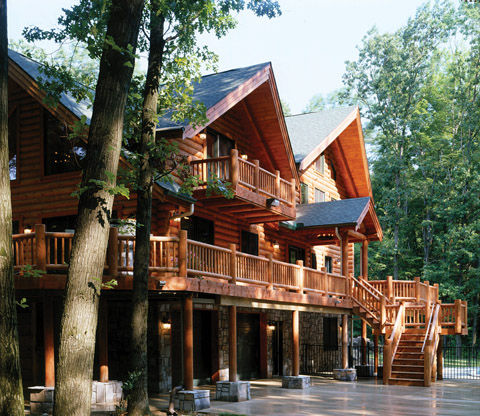For most of us, our home is the biggest investment we’ll make. So it makes sense to spend a little bit of time and effort maintaining that investment. Log homes are naturally stable, but be sure to follow the maintenance recommendations of your log home manufacturer. “The wood, if properly constructed and maintained, is like a fine wine—it improves with age,” says Original Log Cabin Homes President Tom Vesce. “As time goes on it gets better and better.”
Proper maintenance can also help to ensure you’re getting the most energy efficiency out of your home. You’ll be able to use less energy to heat and cool your home, avoid moisture problems, and reduce your energy bills.
Watch Windows and Doors
If you want to improve the energy efficiency of your home, take some time to inspect your home each year and keep an eye out for potential energy sappers. During the winter, check all of your windows and doors to make sure they are well sealed. If you feel a draft, you’ll know you have a leak! Reseal around doors and windows with expanding foam that will fill in any gaps. If it’s time to replace older windows, choose ENERGY STAR® certified windows for replacements.
Test for Leaks
“In the first few years you should be vigilant about checking for air infiltration,” says Lynn Gastineau, president of Gastineau Log Homes. If you feel air leakage is a problem in your home, Gastineau recommends having a blower door test done. “It’s not very expensive, and you could have air coming in places where it would take only five dollars’ worth of caulking to fix it,” she says. A blower door is a fan that is mounted into an exterior door, pulling air out of the house and lowering the air pressure inside. The auditor can then use a smoke pencil to detect air leaks as the higher outside air pressure flows in through any miniscule openings. One common culprit of air leaks is the attic of a home—leaks that often go undetected unless you’re careful to check for them. Once you’ve found sources of air infiltration, seal and, if necessary, add insulation.
.jpg)
“We always tell people to do a yearly walk around their home and when you do see something, take care of it then,” says Mark Elliott, vice president of Coventry Log Homes. Look for checks that may have developed and seal any areas that may look like they need it right away—don’t put it off for later. Properly sealing checks with a caulk made especially for log homes helps prevent air and moisture infiltration and will help lower your power bills!
Elliott also suggests keeping an eye on mechanical systems like water heaters and furnaces to make sure they are performing well. Have your furnace inspected and your air ducts cleaned by a professional every few years. Inspect and change the air filters in your air conditioner and furnace once a month; a dirty filter can lead to 5 to 15 percent higher energy costs. It’s estimated that about 20 percent of the air that moves through the ducts is lost due to leaks, so you may need to check your ducts as well. Consider installing a programmable thermostat to save on your heating and air conditioning bills. You can even buy thermostats that can be controlled remotely, an ideal energy-saver if your log home is used primarily as a vacation home. You can also turn off your water heater when you’re away from home—just turn it back on when you return and you’ll have hot water in an hour.

